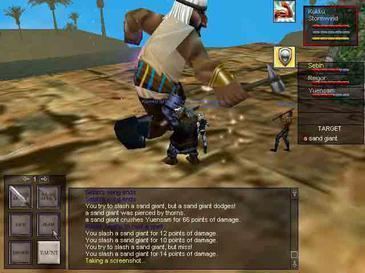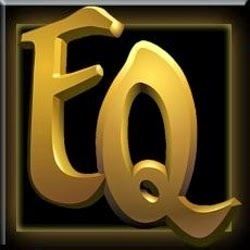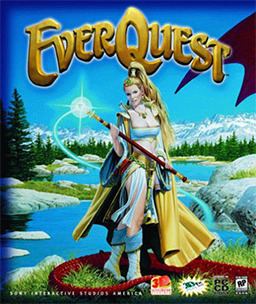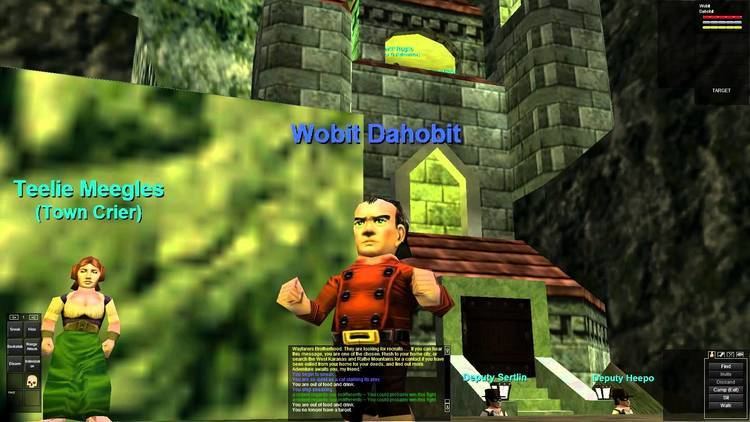7 /10 1 Votes
Release date(s) 16 March 1999 Initial release date 16 March 1999 | 7/10 Steam | |||||||||||||||||||||||||||||||||
 | ||||||||||||||||||||||||||||||||||
Platform(s) Microsoft WindowsOS X (2003–2013) Awards Technology & Engineering Emmy Award for Outstanding Achievement in Video Gaming Technology and Applications Similar Daybreak Game Company games, MMORPGs | ||||||||||||||||||||||||||||||||||
Everquest online adventures revival update
EverQuest is a 3D fantasy-themed massively multiplayer online role-playing game (MMORPG) released on March 16, 1999. It was the second commercially viable MMORPG to be released, after Ultima Online, and the first commercially successful MMORPG to employ a three-dimensional game engine.
Contents
- Everquest online adventures revival update
- Happy 13th anniversary everquest online adventures featuring mrs nostalgia
- Development
- Release
- Subscription numbers
- Growth and sequels
- Decline
- EverQuest Next
- Gameplay
- Classes
- Tank classes
- Damage dealers
- Casters
- Crowd control utility
- Healers
- Deities
- Zones
- Expansions
- Servers
- OS X
- European
- Sale of in game objectsreal world economics
- Intellectual property and role playing
- Addiction
- Sociological aspects of MMORPGs
- Organized protests
- Prohibition in the state of Minas Gerais state of Brazil
- EverQuest universe
- References

EverQuest has had a wide influence on subsequent releases within the market, and holds an important position in the history of massively multiplayer online games. The game surpassed early subscription expectations and grew for many years after its release. It has received awards, including 1999 GameSpot Game of the Year and a 2007 Technology & Engineering Emmy Award.

Happy 13th anniversary everquest online adventures featuring mrs nostalgia
Development

EverQuest began as a concept by John Smedley in 1996. The original design is credited to Brad McQuaid, Steve Clover, and Bill Trost. It was developed by Sony's 989 Studios and its early-1999 spin-off Verant Interactive, and published by Sony Online Entertainment (SOE).
Since its acquisition of Verant in late 1999, EverQuest was developed by Sony Online Entertainment.

The design and concept of EverQuest is heavily indebted to text-based MUDs, in particular DikuMUD, and as such EverQuest is considered a 3D evolution of the text MUD genre like some of the MMOs that preceded it, such as Meridian 59 and The Realm Online. John Smedley, Brad McQuaid, Steve Clover and Bill Trost, who jointly are credited with creating the world of EverQuest, have repeatedly pointed to their shared experiences playing MUDs such as Sojourn and TorilMUD as the inspiration for the game. Famed book cover illustrator Keith Parkinson created the box covers for earlier installments of EverQuest.
Development of EverQuest began in 1996 when Sony Interactive Studios America (SISA) executive John Smedley secured funding for a 3D game like text-based MUDs following the successful launch of Meridian 59 the previous year. To implement the design, Smedley hired programmers Brad McQuaid and Steve Clover, who had come to Smedley's attention through their work on the single player RPG Warwizard. McQuaid soon rose through the ranks to become executive producer for the EverQuest franchise and emerged during development of EverQuest as a popular figure among the fan community through his in-game avatar, Aradune. Other key members of the development team included Bill Trost, who created the history, lore and major characters of Norrath (including EverQuest protagonist Firiona Vie), Geoffrey "GZ" Zatkin, who implemented the spell system, and artist Milo D. Cooper, who did the original character modeling in the game.
Release
EverQuest launched with modest expectations from Sony on 16 March 1999 under its Verant Interactive brand and quickly became successful. By the end of the year, it had surpassed competitor Ultima Online in number of subscriptions. Numbers continued rising rapidly until mid-2001 when growth slowed. Sony's last reported subscription numbers were given as more than 430,000 players on 14 January 2004.
EverQuest initially launched with volunteer "Guides" who would act as basic customer service/support via 'petitions'. Issues could be forwarded to the Game Master assigned to the server or resolved by the volunteer. Other guides would serve in administrative functions within the program or assisting the Quest Troupe with dynamic and persistent live events throughout the individual servers. Volunteers were compensated with free subscription and expansions to the game. In 2003 the program changed for the volunteer guides taking them away from the customer service focus and placing them into their current roles as roving 'persistent characters' role-playing with the players.
In anticipation of PlayStation's launch, Sony Interactive Studios America made the decision to focus primarily on console titles under the banner 989 Studios, while spinning off its sole computer title, EverQuest, which was ready to launch, to a new computer game division named Redeye (renamed Verant Interactive). Executives initially had very low expectations for EverQuest, but in 2000, following the surprising continued success and unparalleled profits of EverQuest, Sony reorganized Verant Interactive into Sony Online Entertainment (SOE) with Smedley retaining control of the company.
Many of the original EverQuest team, including Brad McQuaid, Steve Clover and Geoffrey Zatkin left SOE by 2002.
Subscription numbers
Verant, from 1999 to 2001, and SOE, from 2001 to 14 January 2004, issued formal statements giving some indications of the number of EverQuest subscriptions and peak numbers of players online at any given moment. These records show more than 225,000 subscriptions on 1 November 1999, with an increase to more than 450,000 subscriptions by 25 September 2003.
Growth and sequels
The first four expansions were released in traditional physical boxes at roughly one-year intervals. These were highly ambitious and offered huge new landmasses, new playable races and new classes. The Shadows of Luclin expansion (2001) gave a significant facelift to player character models, bringing the by-then dated 1999 graphics up to modern standards. However, non-player characters which do not correspond to any playable race-gender-class combination (such as vendors) were not updated, leading to the coexistence of 1999-era and 2001-era graphics in many locations. The Planes of Power expansion (2002) introduced The Plane of Knowledge, a hub zone from which players could quickly teleport to many other destinations. This made the pre-existing roads and ships largely redundant, and long-distance overland travel is now virtually unheard of.
EverQuest made a push to enter the European market in 2002 with the New Dawn promotional campaign, which not only established local servers in Germany, France and Great Britain but also offered localized versions of the game in German and French to accommodate players who prefer those languages to English. In the following year the game also moved beyond the PC market with a Mac OS X version.
In 2003 experiments began with digital distribution of expansions, starting with the Legacy of Ykesha. From this point on expansions would be less ambitious in scope than the original four, but on the other hand the production rate increased to two expansions a year instead of one.
This year the franchise also ventured into the console market with EverQuest Online Adventures, released for Sony's internet-capable PlayStation 2. It was the second MMORPG for this console, after Final Fantasy XI. Story-wise it was a prequel, with the events taking place 500 years before the original EverQuest. Other spin-off projects were the PC strategy game Lords of EverQuest (2003) and the co-op Champions of Norrath (2004) for the PlayStation 2.
After these side projects, the first proper sequel was released in late 2004, titled simply EverQuest II . The game is set 500 years after the original, as opposed to EverQuest Online Adventures which took place 500 years before. EverQuest II would face severe competition from Blizzard's World of Warcraft, which was released at virtually the same time and quickly grew to dominate the MMORPG genre.
Decline
Since the release of World of Warcraft and other modern MMORPGs, there have been a number of signs that the EverQuest population is shrinking. The national New Dawn servers were discontinued in 2005 and merged into a general (English-language) European server.
The 2006 expansion The Serpent's Spine introduced the "adventure-friendly" city of Crescent Reach in which all races and classes are able (and encouraged) to start. Crescent Reach is supposed to provide a more pedagogic starting environment than the original 1999 cities, where players were given almost no guidance on what to do. The common starting city also concentrates the dwindling number of new players in a single location, making grouping easier. 2008's Seeds of Destruction expansion introduced computer controlled companions called "mercenaries" that can join groups in place of human players; a response to the increasing difficulty of finding other players of appropriate level for group activities. As of Seeds the production rate also returned to one expansion a year instead of two.
In March 2012 EverQuest departed from the traditional monthly subscription business model by introducing three tiers of commitment: a completely free-to-play Bronze Level, a one-time fee Silver Level, and a subscription Gold Level. The same month saw the closure of EverQuest Online Adventures. Just a few months earlier EverQuest II had gone free-to-play and SOE flagship Star Wars Galaxies also closed.
In June of the same year SOE removed the ability to buy game subscription time with Station Cash without any warning to players. SOE apologized for this abrupt change in policy and reinstated the option for an additional week, after which it was removed permanently.
November 2013 saw the closure of the sole Mac OS server Al'Kabor.
In February 2015 Sony sold its online entertainment division to private equity group Columbus Nova, with Sony Online Entertainment subsequently renamed Daybreak Game Company. An initial period of uncertainty followed, with all projects such as expansions and sequels put on hold and staff laid off. The situation stabilized around the game's 16th anniversary celebrations, and a new expansion was released in November 2015.
EverQuest Next
The third iteration in the series, with the working title EverQuest Next, was under development, with in-game screenshots, concept art, and information revealed at the SOE Fan Faire in August 2010. However, this early version of the game has since been scrapped and development cancelled.
Gameplay
Many of the elements in EverQuest have been drawn from text-based MUD (Multi-User Dungeon) games, particularly DikuMUDs, which in turn were inspired by traditional role-playing games such as Dungeons & Dragons. In EverQuest, players create a character (also known as an avatar, or colloquially as a char or toon) by selecting one of sixteen races in the game, which range from humans (basic Caucasian-looking human, dark-skinned Erudite, and barbarian), elves (high elves, wood elves, and dark elves), half-elves, dwarves, gnomes, halflings, trolls, and ogres, to cat-people (Vah Shir), lizard-people (Iksar), frog-people (Froglok), and dragon-people (Drakkin). At creation, players select each character's adventuring occupation (such as a wizard, ranger, or cleric — called a class — see below for particulars), a patron deity, and starting city. Customization of the character facial appearance is available at creation (hair, hair color, face style, facial hair, facial hair color, eye color, etc.).
Players move their character throughout the medieval fantasy world of Norrath, often fighting monsters and enemies for treasure and experience points, and optionally mastering trade skills. As they progress, players advance in level, gaining power, prestige, spells, and abilities through valorous deeds such as entering overrun castles and keeps, defeating worthy opponents found within, and looting their remains. Experience and prestigious equipment can also be obtained by completing quests given out by non-player characters found throughout the land.
EverQuest allows players to interact with other people through role-play, joining player guilds, and dueling other players (in restricted situations – EverQuest only allows player versus player (PVP) combat on the PvP-specific server, specified arena zones and through agreed upon dueling).
The game-world of EverQuest consists of over five hundred zones.
Multiple instances of the world exist on various servers. In the past, game server populations were visible during log-in, and showed peaks of more than 3000 players per server. The design of EverQuest, like other massively multiplayer online role-playing games, makes it highly amenable to cooperative play, with each player having a specific role within a given group.
Classes
The fourteen classes of the original 1999 version of EverQuest were later expanded to include the Beastlord and Berserker classes with the Shadows of Luclin (2001) and Gates of Discord (2004) expansions, respectively.
The classes can be grouped into five general roles that share similar characteristics, as described below.
Tank classes
Members of this group have a high number of hitpoints for their level, and can equip heavy armor. They have the ability to taunt enemies into focusing on them, either directly or through the use of aggravating spells and abilities. This is to keep their more lightly-armored companions alive and well, who may otherwise provoke the wrath of one or more deadly creatures.
Damage dealers
The following classes are able to deal high corporal damage to opponents. Within the game, these classes are often referred to as 'DPS', which stands for Damage Per Second. There isn't a definitive top DPS class, as damage dealt will depend on numerous factors which vary from one encounter to another (such as the enemy's armor, its positioning, and its magic resistance). Another complication is that while Wizards can readily deal tremendous damage to enemies, their ability to do so is limited by their remaining mana pool, as well as how fast they are able to regenerate mana. That said, Berserkers, Rogues, and Wizards are three classes most commonly cited as the highest overall damage dealers.
These melee damage dealers have a medium number of hit points per level, but cannot wear the heaviest armors and are less likely than a tank class to be able to survive direct attacks for a sustained period of time.
Casters
Caster classes have the lowest hit points per level and can only wear the lightest of armors. Casters draw their power from an internal pool of mana, which takes some time to regenerate and thus demands judicious and efficient use of spells.
Crowd control / utility
These classes share the ability to prevent enemies from attacking the party, as well as improving mana regeneration for themselves, teammates, and in the Enchanter's case, anyone they come across.
Healers
Priest classes have medium level of hit points per level and have access to healing and "buff" spells.
Deities
There are several deities in EverQuest who each have a certain area of responsibility and play a role in the backstory of the game setting. A wide array of armor and weapons are also deity-tied, making it possible for only those who worship that deity to wear/equip them. Additionally, deities determine, to some extent, where characters may and may not go without being attacked on sight.
Zones
The EverQuest universe is divided into more than five hundred zones. These zones represent a wide variety of geographical features, including plains, oceans, cities, deserts, and other planes of existence. One of the most popular zones in the game is the Plane of Knowledge, one of the few zones in which all races and classes can coexist harmoniously without interference. The Plane of Knowledge is also home to portals to many other zones, including portals to other planes and to the outskirts of nearly every starting city.
Expansions
There have been twenty-two expansions to the original game since release. Expansions are purchased separately and provide additional content to the game (for example: raising the maximum character level; adding new races, classes, zones, continents, quests, equipment, game features). Additionally, the game is updated through downloaded patches. The EverQuest expansions:
Servers
The game runs on multiple game servers, each with a unique name for identification. These names were originally the deities of the world of Norrath. In technical terms, each game server is actually a cluster of server machines. Once a character is created, it can be played only on that server unless the character is transferred to a new server by the customer service staff, generally for a fee. Each server often has a unique community and people often include the server name when identifying their character outside of the game.
OS X
SOE devoted one server (Al'Kabor) to an OS X version of the game. The game was never developed beyond the Planes of Power expansion. In January 2012, SOE announced plans to shut down the server, but based on the passionate response of the player base, rescinded the decision and changed Al'Kabor to a free-to-play subscription model. At about the same time, SOE revised the Macintosh client software to run natively on Intel processors. Players running on older, PowerPC-based systems lost access to the game at that point. Finally in November 2013, SOE closed Al'Kabor.
European
Two SOE servers were set up to better support players in and around Europe: Antonius Bayle and Kane Bayle. Kane Bayle was merged into Antonius Bayle.
With the advent of the New Dawn promotion, three additional servers were set up and maintained by Ubisoft: Venril Sathir (British), Sebilis (French) and Kael Drakkal (German). The downside of the servers was that while it was possible to transfer to them, it was impossible to transfer off.
The servers were subsequently acquired by SOE and all three were merged into Antonius Bayle server.
Sale of in-game objects/real world economics
The sale of in-game objects for real currency has often been a point of contention. The developers of EQ have always forbidden the practice. In fact, in 2001, eBay banned these sales.
Because items can be traded within the game and also because of illegal online trading on websites, virtual currency to real currency exchange rates have been calculated. The BBC reported that in 2002 work done by Edward Castronova showed that EverQuest was the 77th richest country in the world, sandwiched between Russia and Bulgaria and its GDP per capita was higher than that of the People's Republic of China and India. In 2004, a follow-up analysis of the entire online gaming industry indicated that the combined GDP of the online "worlds" populated by the two million players was approximately the same as that of Namibia.
Companies created characters, leveled them to make them powerful, and then resold the characters or specialized in exchanging money between games. A player could exchange a house in The Sims Online for EverQuest platinum pieces, depending solely on market laws of supply and demand.
Sony officially discourages the payment of real-world money for online goods, except on certain "Station Exchange" servers in EverQuest II, launched in July 2005. The program facilitates buying in-game items for real money from fellow players for a nominal fee. At this point this system only applies to select EverQuest II servers; none of the pre-Station Exchange EverQuest II or EverQuest servers are affected.
Intellectual property and role-playing
Another well-publicized incident from October 2000, usually referred to as the "Mystere incident", involved Verant banning a player for creating controversial fan fiction, causing outrage among some EverQuest players and sparking a major industry-wide debate about players' rights and the line between roleplaying and intellectual property infringement. The case was used by several academics in discussing such rights in the digital age.
Fans have created the open source server emulator EQEmu(Proyect1999) , which lets users run their own servers with custom rules.
Addiction
Some argue the game has addictive qualities. Many players refer to it as "EverCrack" (a comparison to crack cocaine). There was one well-publicized suicide of an EverQuest user named Shawn Woolley, that inspired his mother, Liz, to found Online Gamers Anonymous.
Sociological aspects of MMORPGs
Massively multiplayer online role-playing games (MMORPGs) are described by some players as "chat rooms with a graphical interface". The sociological aspects of EverQuest (and other MMORPGs) are explored in a series of online studies on a site known as "the HUB". The studies make use of data gathered from player surveys and discuss topics like virtual relationships, player personalities, gender issues, and more.
Organized protests
In May 2004, Woody Hearn of GU Comics called for all EverQuest gamers to boycott the Omens of War expansion in an effort to force SOE to address existing issues with the game rather than release another "quick-fire" expansion. The call to boycott was rescinded after SOE held a summit to address player concerns, improve (internal and external) communication, and correct specific issues within the game.
Prohibition in the state of Minas Gerais state of Brazil
On 17 January 2008, the Judge of the 17th Federal Court of Minas Gerais State forbade the sales of the game in that Brazilian territory. The reason was that the game leads the players to a loss of moral virtue and takes them into "heavy" psychological conflicts because of the game quests.
EverQuest universe
Since EverQuest's release, Sony Online Entertainment has added several EverQuest-related games. These include:
A line of novels have been published in the world of EverQuest, including:
